Can I Use Plain Flour for Pizza Dough? (Explained)
Everyone wants to get the specifics right regarding cultural dishes like Italian pizzas. And that ranges from the pizza crust to the toppings till the finish.
The best pizza starts from having the perfect dough. But, to get the perfect pizza dough for the crust, you will need the best flour.
This might make you wonder if you can use plain flour for your pizza dough.
Yes! You can use plain flour for pizza dough. Italian pizza recipes do not lie heavily on the type of flour used. Instead, it relies on technique and the ingredients used. Plain flour also goes a long way in helping to accentuate the taste of the pizza dough since it allows for components to remain in their natural flavor.
Discover the truth about wheat flour pizza dough, all-purpose flour in pizza, and how kitchen staples like regular and unbleached plain flour influence crust quality.
Stay tuned to learn about simple flour bases and the debate: all-purpose vs. bread flour for your perfect pizza dough!
Understanding the Role of Protein Content in Flour for Pizza Dough

When making wheat flour pizza dough, it’s crucial to comprehend how protein content affects your final product.
After all, who would want to avoid achieving that seamless balance between chewiness and crispness in each bite? Let’s dive into why protein matters.
The Impact of Protein on Pizza Dough Texture
Flour contains gluten, a protein that is activated when you start kneading your homemade pizza dough ingredients.
The more you knead your dough, the more this protein comes into play to create structure and texture.
- Bread flour has a higher protein content, resulting in a crispier crust.
- All-purpose or plain flour: These have lower protein content, yielding a softer crust.
The choice between using standard flour for baking or bread flour boils down to your personal preference!
Can Regular Flour Make Good Crusts?
Absolutely! While some might argue that baking pizza with plain flour might not yield an ideal crunch, others appreciate its versatility and accessibility for bread-making.
Despite having lower protein content than bread or ’00’ flours, regular (plain) flours can still produce delicious results.
So yes, if you’re after an accessible option for home cooking without needing specialty flours, consider using all-purpose or unbleached plain recipes, as they can make delicious pizza crusts.
Variety is Everything: Different Flours For Baking Pizza Crusts
Even when we focus on simple ingredients like creating a simple flour pizza base – there are so many varieties of flours you could experiment with:
- Bread Flour
- All-Purpose Flour
- Plain Flour
Remember, different flours require varying amounts of water and kneading time.
All-purpose Flour vs Bread Flour for Pizza Dough: The Age-Old Debate
While bread flour tends to be a popular choice for its high protein content, giving that ideal crispy crust, all-purpose flour in pizza making is just as valid.
Your choice depends on your taste and the type of crust you prefer.
The table below highlights the cons and pros you get from using either all-purpose flour or bread flour:
| Characteristics | All-Purpose Flour | Bread Flour |
|---|---|---|
| Protein content | Typically around 10-12% | Typically, around 12-14% |
| Gluten Development | Less gluten development | Strong gluten development |
| Texture | Softer, less chewy | Chewier, more elastic |
| Crust texture | Thinner crispier | Thicker and chewier |
| Kneading requirement | Requires less kneading | Requires more kneading |
So next time you’re whipping up some delicious homemade pizza dough – don’t forget to consider the role of protein content.
Exploring Different Types of Flour for Various Pizza Crust Preferences
Let’s dig into the beautiful world of flour and find out how each can impact your homemade pizza dough.
Different Flours, Different Tastes
Have you ever wondered how using different types of flour could change your pizza crust’s taste and texture?
Even though plain flour can still produce a tasty pizza crust, did you know that the type of flour you use extensively depends on your personal preference for crust texture?
Grab some plain flour if you’re after a chewier, crispier crust. This is because plain flour gives less rise to the dough due to its lower protein content.
For those who prefer their pizza with a thin and crispy base, both all-purpose (or plain) and bread flour work great.
Whatever way you slice it, there’s a type for everyone!
Baking Pizza with Plain or All-Purpose Flour Vs. Bread Flour
Let’s compare baking pizza with plain or all-purpose flour versus using bread (firm) or ’00’ flour:
- Plain or All-Purpose Flour:
- – Lower protein content
- – Gives less rise to the dough
- – Results in a chewy but crispy crust
- Bread (firm) or ’00’ Flours:
- – Higher protein content
- – Leads to better textural results in pizza crusts
Even though professional chefs might lean towards higher-protein flours like bread or ’00’ varieties when making gourmet pies, using standard flour for baking at home is perfect, too!
Homemade pizzas made from regular flour often have an irresistible rustic charm.
Remember this golden rule:
No matter which type of wheat-based product ends up in your kitchen staples for bread making—be it
- unbleached plain,
- regular, or
- anything in-between
each requires different amounts of water and kneading time due to their varying protein contents.
Experimenting with Different Flours for Baking Pizza Crusts
The best way to discover which flour you prefer is through experimenting. Try various homemade pizza dough ingredients and see what works best for your palate.
Here are some ideas:
- Combine plain flour with yeast or even Greek yogurt
- Use different types of flour in a simple flour pizza
Considering Water and Kneading Time for Different Types of Flour
Understanding the Importance of Hydration and Kneading Time
When making your homemade pizza dough, you should always pay attention to the amount of water or other hydrating ingredients you use and the kneading period.
The balance between these elements depends predominantly on your choice of flour.
All-purpose flour in pizza requires less water than high-protein flour such as bread or wheat flour.
This is due to its lower protein content, which absorbs less hydration. Consequently, using all-purpose or plain flour for baking typically results in a softer crust.
Here’s what you need to remember:
- All-purpose (plain) flours require less water than their high-protein counterparts.
- The kneading time with all-purpose flours could be shorter since there’s less protein to develop through kneading.
- Due to its lower protein content, you’ll achieve a softer crust when baking pizza with plain flour.
A Look at Regular Flour for Dough: Water Ratio and Kneading Time
Let’s delve deeper into using standard flour, like unbleached plain flour recipes in our pizza dough. How much water do we have to add?
While precise measurements can vary depending on specific recipes, a typical rule is adding around 60% water by weight of the wheat flour used in your pizza dough.
The kneading time here is essential, too! It helps develop gluten from proteins in the flour—a critical step in defining our consistency and elasticity.
But don’t overdo it; too much kneading can toughen your dough.
Remember this:
- The general rule is to add about 60% water to the weight of the flour.
- Stay under-knead, as over-kneading could make your dough tough.
The Tale of Different Flours for Baking Pizza Crusts: A Comparison
You might wonder, “Can regular flour make good crusts, or should I try other types?” It’s a valid question. Regular or plain flour offers promising results for pizza crust.
Experimenting with Recipes: Incorporating Other Ingredients with Plain Flour for Pizza Dough
Ready to have some fun in the kitchen? Let’s dive into the world of homemade pizza dough ingredients.
Understanding how to substitute ingredients can alter the texture and taste of your pizza. You’ll discover that even using standard flour for baking can create an enjoyable crust.
Wheat Flour Pizza Dough vs. All-Purpose Flour In Pizza
Some might argue that wheat flour pizza dough is superior but don’t discount all-purpose or plain flour.
It lends itself beautifully to a simple flour pizza base, yielding a soft yet crisp crust – perfect for a thin, crispy pizza fan.
Baking Pizza with Plain Flour: Regular Flour for Dough
Regular or plain flour does indeed make good crusts! Although its protein is less than bread flour, it’s perfectly suitable for making delicious pizza dough.
Remember though:
- The amount of water and kneading time required will differ due to protein content.
- If craving a chewy but crispier crust, use bread (firm) or ’00’ flours instead.
Incorporating Other Kitchen Staples in Bread Making and Unbleached Plain Flour Recipes
Next time you’re making homemade pizza dough, think about whether you want to add additional ingredients like yeast or Greek yogurt.
They provide the necessary lift, which enhances its overall texture.
Remember not to replace specified flours in recipes – self-rising should never substitute plain or all-purpose flours unless explicitly stated.
In conclusion, different flours have distinct characteristics influencing baking results; concerning all-purpose flour vs. bread Flour for Pizza Dough, don’t be afraid to experiment.
The most perfect pizza crust might be a kneading session away! So, start prepping for your next pizza party and discover the joy of homemade, perfectly crusted pizzas.






